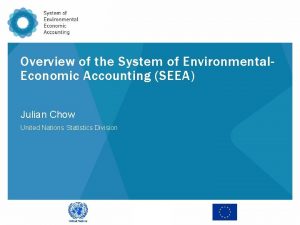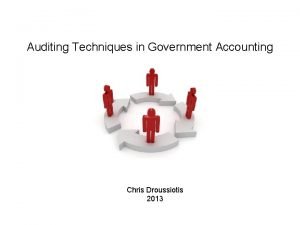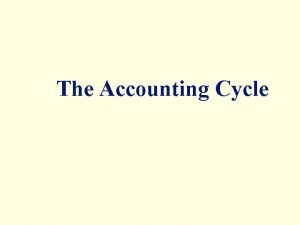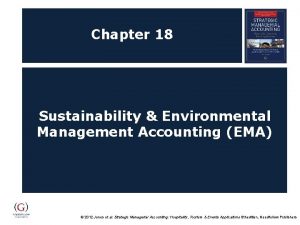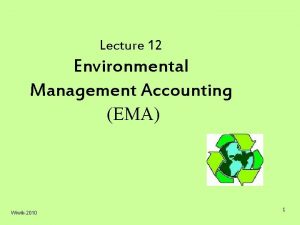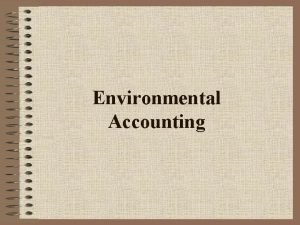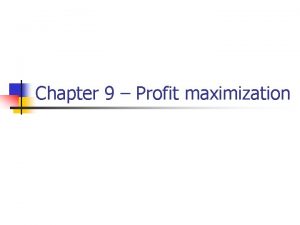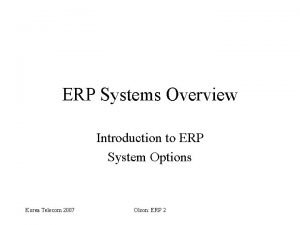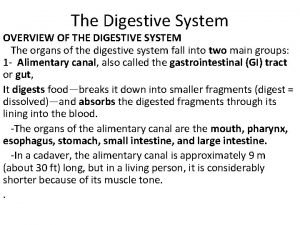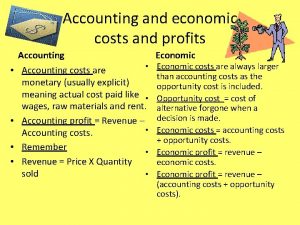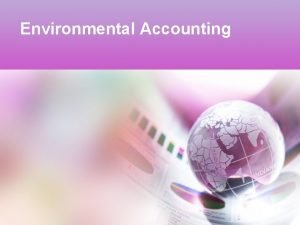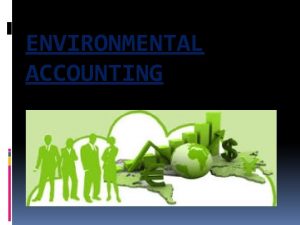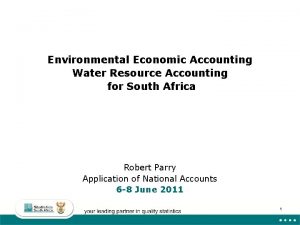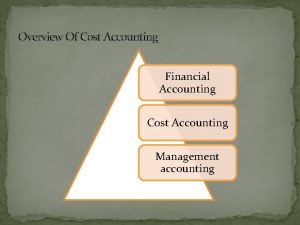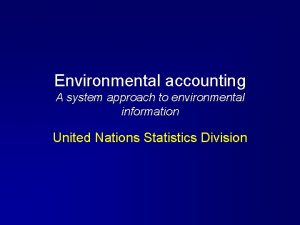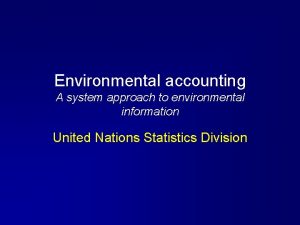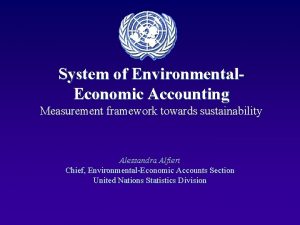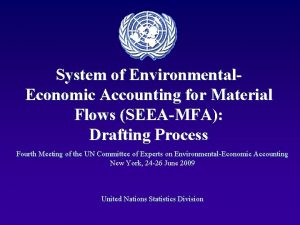Overview of the System of Environmental Economic Accounting
















- Slides: 16

Overview of the System of Environmental. Economic Accounting (SEEA) Julian Chow United Nations Statistics Division

Natural Capital Accounting – balancing the book of natural capital Assets Services Regeneration Waste & degradation Economy and well -being

System of Environmental-Economic Accounting (SEEA) • The SEEA Central Framework was adopted as an international statistical standard by the UN Statistical Commission in 2012 • The SEEA Experimental Ecosystem Accounting complements the Central Framework and represents international efforts toward coherent ecosystem accounting

The SNA and SEEA: Systems of integrated information

National wealth SEEA Stocks (P & Q) Minerals & energy Land, Soil Timber Aquatic Other biological Environment Flows (P & Q) • National Balance Sheet • Resource life • “Critical” Natural Capital Materials Benefits/Costs Minerals & energy Water Energy Ecosystems + conditions Water Economy Ecosystem services Production Consumption Accumulation Imports Exports Mitigate & Manage (P) Protection $ Goods & Services Taxes & subsidies • SNA: Contribution of natural inputs to economy (rent) • Depletion, degradation adjusted net savings • Non-SNA: Contribution of natural inputs to well being • Externalities (health, poverty)

One Environment: Two perspectives Individual environmental assets & resources: Timber Water Soil Fish SEEA Central Framework (SEEA_CF) starts with economy and links to physical information on natural assets, flows and residuals Ecosystems: Biotic and abiotic elements functioning together: Forests Lakes Cropland Wetlands SEEA Experimental Ecosystem Accounting (SEEA-EEA) starts with ecosystems and links their services to economic and other human activity Together, they provide the foundation for measuring the relationship between the environment, and economic and other human activity

SEEA-CF (Central Framework) • Assets • Physical flows • Monetary flows SEEA Water; SEEA Energy; SEEA Agriculture, Forestry and Fisheries Add sector detail Adds spatial SEEA-EEA detail and (Experimental Ecosystem Accounting) ecosystem perspective • Minerals & Energy, Land, Timber, Soil, Water, Aquatic, Other Biological • Materials, Energy, Water, Emissions, Effluents, Wastes • Protection expenditures, taxes & subsidies As above for • Water • Energy • Agricultural, Forestry and Fisheries Extent, Condition, Ecosystem Services, Thematic: Carbon, Water, Biodiversity

SEEA-CF – Asset accounts Assets (=stocks; physical and monetary) • Opening balance; additions; removals. Closing balance > Mineral and energy resources > Land, Forest > Soil > Timber > Aquatic resources > Other biological resources > Water Source: Statistics Canada

General structure of the physical account for environmental assets (physical units) Mineral & energy Land (incl. Soil resources forest land) Opening stock of resources Additions to stock of resources Growth in stock Timber resources Aquatic resources Cultivated Natural Yes Yes na Yes* Soil formation Growth Natural growth Precipitation Soil deposition Water resources Return flows Discoveries of new stock Yes na na Yes* Upwards reappraisals Yes Yes* Yes* Reclassifications Yes Yes Extractions na Harvest Gross catch Abstraction na na Erosion Natural losses Normal losses Catastrophic losses Yes* Yes Yes Yes* Downwards reappraisals Yes Yes* Yes* Reclassifications Yes Yes na Yes Yes Total additions to stock Reductions in stock of resources Extractions Normal reductions in stock Total reductions in stock Closing stock of resources Soil extraction Removals Normal Evaporation losses Evapotranspiration

SEEA-CF – Physical flow accounts Physical flows • Supply/use of materials (extract consume) • Material flows (through economy) to final demand (e. g. , GHGs) > Water supply/use > Energy supply/use > Residuals > Air emissions > Water emissions > Wastes (generated and used/recycled) Source: Statistics Denmark

SEEA-CF – Environmental activity accounts Environmental activities • Expenditures on protection, management and regulation > EPE: Environmental protection expenditures (demand side) > EGSS: Environmental goods and services sector (supply side) > Resource use and management > Environmentally-related payments by & to government (fines, fees, taxes, subsidies, concession payments) EGSSs in Netherlands Source: Statistics Netherlands

Ecosystem Accounting model

Broad steps in ecosystem accounting a. Physical Accounts Ecosystem thematic accounts: Land, Carbon, Water, Biodiversity Supporting information: Socio-economic conditions and activities, ecological production functions Tools: classifications, spatial units, scaling, aggregation, biophysical modelling Source: Official statistics, spatial data, remote sensing data b. Monetary Accounts Supporting information: SNA accounts, I-O tables Tools: Valuation techniques

International bodies for SEEA United Nations Committee of Experts on Environmental Economic Accounting (UNCEEA) The governing body for the mainstreaming and implementation of the SEEA. Established by the UN Statistical Commission at its 36 th Session in 2005. Chair: Bert Kroese, Statistics Netherlands || Secretariat: UNSD Technical Committee of the SEEA Central Framework Technical Committee of the SEEA Experimental Ecosystem Accounting London Group on Environmental Economic Accounting Forum of Experts on SEEA Experimental Ecosystem Accounting

Status of SEEA implementation Status of SEEA Implementation (2014) 35 31 • Global Assessment on Environmental Economic Accounting 2014 > 84 countries responded 30 25 > 54 countries have an SEEA program 23 • 20 15 • 5 0 > Air Emissions, Material Flows, Energy (due to Eurostat legislation) 12 10 3 Countries with an SEEA programme Developed Countries planning an SEEA programme Developing Accounts most commonly compiled; Priorities accounts going forward; > Developed Countries: Energy, EPEA and EGSS > Developing Countries: Energy, Water and Environmental Taxes and Subsidies

THANK YOU seea@un. org
 System of environmental-economic accounting upsc
System of environmental-economic accounting upsc Introduction to computerized accounting
Introduction to computerized accounting Overview of government accounting
Overview of government accounting Process of accounting
Process of accounting Wireless health
Wireless health Economic growth vs economic development
Economic growth vs economic development Conclusion of growth and development
Conclusion of growth and development Economic systems lesson 2 our economic choices
Economic systems lesson 2 our economic choices Environmental management accounting definition
Environmental management accounting definition Management accounting vs financial accounting ppt
Management accounting vs financial accounting ppt Environmental management accounting definition
Environmental management accounting definition Scope of environmental accounting
Scope of environmental accounting Normal profit economics
Normal profit economics Economic profit vs accounting profit
Economic profit vs accounting profit Erp system overview
Erp system overview Content management system overview
Content management system overview Overview of the digestive system
Overview of the digestive system
